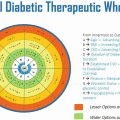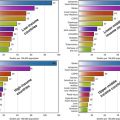Fig. 4.1
Ethnicity of the MENA region (Source: 2010 WHO statistics)

Fig. 4.2
Comparative prevalence of diabetes in MENA (Source: IDF Diabetes Atlas)
Diabetes is a global pandemic affecting more than 415 million adults worldwide. This number is expected to surge to 642 million by 2040 [1]. According to the International Diabetes Federation (IDF), over 35 million people in MENA have diabetes. Saudi Arabia leads the MENA region with the highest prevalence of diabetes (23.9 %), and Egypt is the country with the largest number of diabetes patients (7.5 million) [1]. The rapid rise is due to a multitude of factors, including economic and demographic changes over the last few decades that have led to a decrease in physical activity and rise in obesity. The MENA region has among the highest obesity rates in the world (Fig. 4.3).
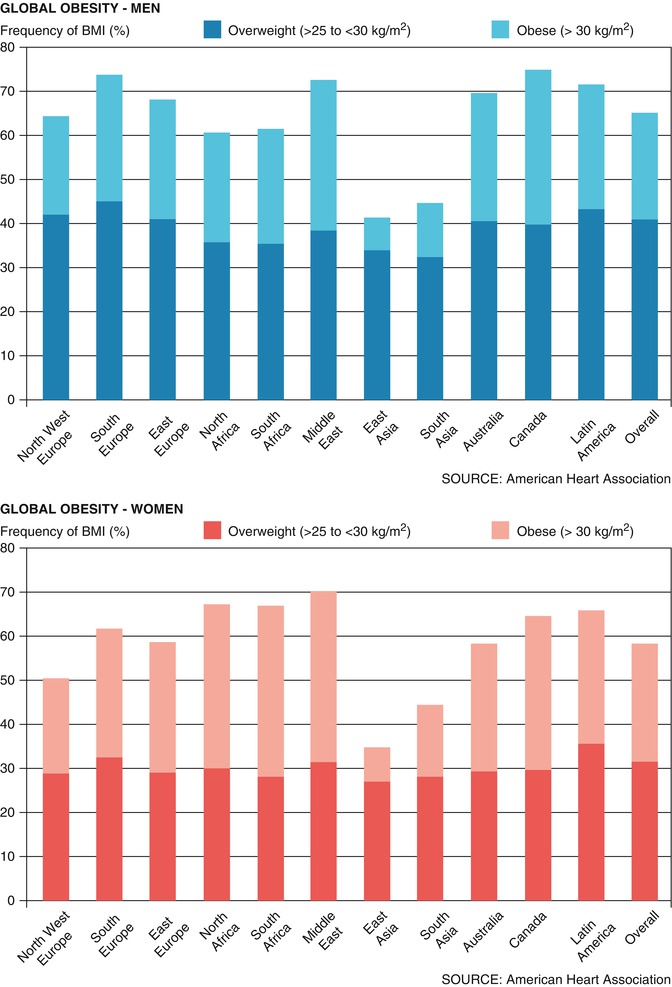

Fig. 4.3
Global prevalence of obesity (Source: AHA)
Diabetes is associated with early mortality and increased risk for microvascular and macrovascular complications. Approximately 40 % of patients with diabetes have chronic kidney disease, and almost 60–70 % of patients with diabetes have mild to severe forms of nervous system damage. In addition, patients with diabetes are two to four times more likely to have fatal or nonfatal coronary events or stroke. Almost 70–80 % of patients with diabetes die from one of these two conditions. The American Heart Association considers diabetes to be one of the six major controllable risk factors for cardiovascular disease. Researchers also consider diabetes as a risk equivalent to having a prior heart attack.
In addition to being a major public health problem, diabetes is also associated with significant healthcare costs. Worldwide, the global cost of diabetes continues to soar and is now estimated to be 825 billion dollars per year [2]. The IDF estimates that in 2015, countries in the Middle East spent over 17 billion dollars on diabetes care. This figure accounts for only 2.5 % of global spending on the disease [1]. Healthcare expenditure varies greatly across the region due to economic inequalities. In Egypt, a cost analysis from 2010 estimated the economic impact of diabetes to be $1.29 billion. This number excluded the cost associated with prediabetes and also the cost related to loss of productivity. This figure, adjusted for inflation, can be expected to double by the year 2030. According to the IDF, in Egypt the current spending on diabetes is among the lowest in the MENA at $116 per patient per year (16 % of total healthcare expenditure). Countries with the highest spending per person with diabetes are Qatar, Kuwait, UAE, and Bahrain, with a range of $1,000–2,000 per year. This is still lower than spending for developed countries, which usually ranges from $2,000 to 7,000 per patient per year [1]. The rising epidemic will continue to strain the economies of the MENA region, and health authorities should urgently address the problem of diabetes to avoid major spending on healthcare in the coming years.
Epidemiology of Diabetes in MENA
The MENA region can be described as a global hotspot for diabetes. According to the IDF, approximately 37 million adults aged 20–79 are living with diabetes across the region. By 2040, this number is expected to rise to 72 million. Of particular concern is that over 40 % of individuals with diabetes are undiagnosed and are at increased risk for developing complications from diabetes. Moreover, in 2015 there were 342,000 deaths related to diabetes. A further 30.2 million people in the region, or 7.8 % of the adult population, are estimated to have impaired glucose tolerance and are therefore at high risk of developing diabetes in the future [1].
Prevalence of Diabetes
Diabetes prevalence varies greatly across the region. The highest prevalence is seen in the Gulf countries, with Saudi Arabia, Kuwait, and Bahrain leading the way (Fig. 4.4). The high rates of diabetes are due in large part to the economic growth of the last few decades and the subsequent change in diet and lifestyle of these populations. Saudi Arabia has a diabetes prevalence of 23.9 % among adults. The prevalence is higher among Saudis residing in urban areas (25.5 %) when compared to rural areas (19.5 %) [3]. There is little gender difference with respect to diabetes prevalence in the region. As expected, type 2 diabetes (T2D) cases predominate and constitute approximately 90–95 % of all patients with diabetes. However, it is worth mentioning that Saudi Arabia has one of the world’s highest annual incidence rates of type 1 diabetes in children, with 31.4 new cases per 100,000 individuals per year [4]. This is the highest incidence of type 1 diabetes of any country outside of Europe.
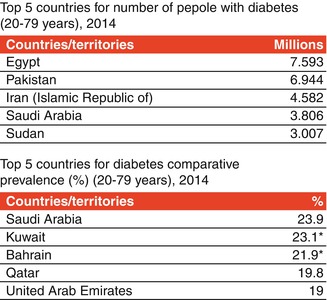

Fig. 4.4
Diabetes in the MENA region, 2014 (Source: IDF Atlas, sixth edition)
The countries with the largest number of people affected by diabetes are Egypt (7.5 million), Pakistan (7 million), and Iran (4.5 million) (Fig. 4.4). These figures reflect the large populations of these countries. In Egypt, the prevalence of diabetes is around 15.6 % among adults between 20 and 79 years of age. The International Diabetes Federation (IDF) estimates that 7.5 million individuals in Egypt have diabetes and another 2.2 million have prediabetes. Furthermore, reports indicate that 43 % of patients with diabetes and most patients with prediabetes in Egypt are likely undiagnosed. It is estimated that 42 % of patients with diabetes in Egypt have retinopathy, 5 % are legally blind, and 22 % have peripheral neuropathy. Diabetes is also the leading cause of end-stage renal disease and leg amputation in Egypt [5–7]. It is especially alarming that the prevalence of diabetes in Egypt has increased rapidly within a relatively short period of time from approximately 4.4 million in 2007 to 7.5 million in 2013. This number is projected to rise to 13.1 million by 2035 (Fig. 4.5).
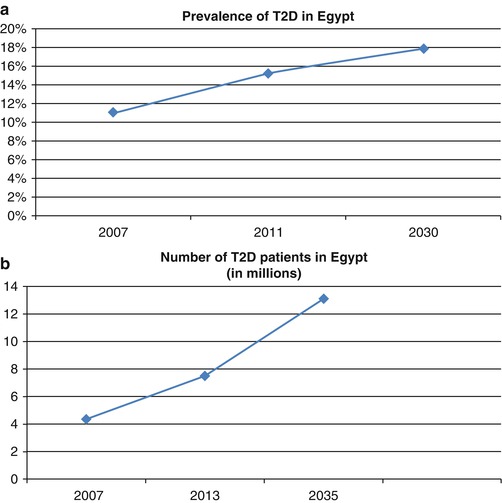

Fig. 4.5
The rising prevalence of type 2 diabetes in Egypt. (a) Projected trends of the prevalence rate of T2D in Egypt. (b) The projected trend of the total number of patients with T2D in Egypt
Prevalence of Diabetes Complications
Among patients with diabetes, the prevalence of microvascular and macrovascular complications is relatively high in Arab populations. A recent cross-sectional study from Saudi Arabia showed that the prevalence of peripheral neuropathy among patients with diabetes was 19.9 % [8]. Among Saudi patients with T2D for at least 10 years, the prevalence of retinopathy was 31 % [9]. In Jordan, data from a national diabetes center showed that 45 % of patients had retinopathy, 33 % had nephropathy, and 5 % had a history of amputation [10]. Diabetes is also frequently associated with psychological distress. A study from UAE demonstrated that up to 33.8 % of patients with diabetes had depression or anxiety or both [11]. Diabetic patients with depression are less likely to adhere to medical treatment and engage in self-care. Overall, the high prevalence of diabetic complications in this region highlights the need for early detection and prompt treatment of this disease.
Risk Factors for Type 2 Diabetes in the MENA Region
Obesity
Obesity and physical inactivity are the two major risk factors for diabetes in the MENA region. The countries with the highest prevalence of obesity are Saudi Arabia, United Arab Emirates, and Egypt (Fig. 4.6). Over the last few decades, there has been a dramatic increase in obesity, particularly among Arab women. Results from a national survey conducted in Saudi Arabia showed the prevalence of obesity was 44 % among women and 26 % among men [12]. Similar results were seen in the 2008 Egypt Demographic and Health Survey, which assessed the nutritional status of adults aged 15–59 years old, and found that approximately 50 % of men and 65–80 % of women were overweight or obese [13]. The Egyptian National Hypertension Survey program, which was conducted in six Egyptian governorates and included 2,313 adults older than 25 years of age, showed that 50 % of surveyed individuals had central obesity. This was shown to be strongly associated with increased risk of diabetes and cardiovascular disease [14–16].
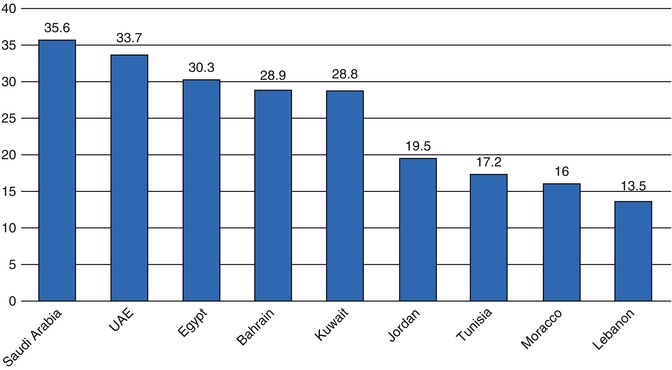

Fig. 4.6
Prevalence (%) of obesity in Arab countries (Source: 2010 WHO statistics)
An alarming trend is the increased rates of obesity among children and adolescents. Obesity during childhood is a risk factor for obesity and related chronic diseases during adulthood, such as cardiovascular disease, diabetes mellitus, and hypertension. The highest prevalence of obesity among children has been reported in Bahrain (38.5 %), while the lowest was reported in Iran (3 %) [17]. Cross-sectional data from Saudi Arabia showed that a very high proportion of Saudi adolescents (84 % of males and 91.2 % of females) spent more than 2 h on TV or video screen daily and almost half of the males and three-quarters of the females did not meet daily physical activity guidelines [18]. In Egypt, data from the most recent Demographic and Health Survey show that 35 % of males and 36 % of females aged 5–19 are overweight [13]. These trends are largely the result of an unhealthy eating pattern and decreased physical activity that has emerged over the last few decades.
Genetics of Diabetes
Central adiposity is common among Arab populations and genetic factors are likely to play a role in the development of obesity and diabetes. The genetics underlying T2D is multifactorial and complex in nature. Although genetic studies from the region are limited, there is evidence that variations in the ADIPOQ gene, which encodes adiponectin, are associated with increased BMI and waist circumference [19]. Adiponectin is released by adipocytes and is found in lower levels among obese subjects. Recent studies from Jordan and Tunisia have also shown that variants in the ADIPOQ gene strongly correlate with risk of T2D [20, 21]. In the Lebanese population, mutations in both CDKAL1 and IGF2BP2 genes have been shown to be associated with T2D [22, 23]. Interestingly, variants of the TCF7L2 gene, which have been associated with T2D across multiple ethnic groups, have only a weak association with diabetes in Arab populations. Another consideration is that the genetic risk is increased among populations that have traditions of consanguineous marriages. Certainly more research is needed to further our understanding of the genetic basis of diabetes in this region.
Physical Inactivity
Physical inactivity is the other major risk factor for the development of T2D in MENA. Rapid economic development, increased availability of cars, access to migrant labor, and widespread use of computers and television have all contributed to a sedentary lifestyle. Low levels of physical activity are prevalent throughout the region. In a cross-sectional study of adults in Saudi Arabia aged 30–70, the prevalence of inactivity was very high at 96.1 % [24]. In Cairo, absence of weekly physical activity was reported among 81 % of the 4,918 households surveyed in 1995 [13]. The majority of individuals did not engage in any physical activity or walk regularly. Physical activity levels were especially low among women [24]. The major reasons for decreased physical activity, particularly among Egyptian women, include the general lack of exercise facilities, overcrowded urban cities, and poor physical education in schools [13]. Furthermore, urban planning in many cities does not encourage or support an active lifestyle. The lack of regular physical activity represents a major public health concern that needs to be addressed by each individual country in a culturally appropriate way.
Chronic Hepatitis C Infection
The burden of hepatitis C virus (HCV) is growing in the MENA region. If untreated, HCV can lead to liver cirrhosis, hepatocellular cancer, and death. Egypt has the highest prevalence of chronic hepatitis C infection in the world. This is attributed to the mass intravenous treatment campaign of bilharziasis between 1960 and 1980 with the use of poorly sterilized needles. The Egypt Demographic and Health Survey showed that 15 % of Egyptians are serologically positive for HCV antibodies and 10 % have active infection [13]. Meanwhile in the Gulf region, infection rates are relatively low. In Qatar, 1.1 % of the population carries the virus.
The prevalence of T2D among patients with HCV is 13–33 %. A meta-analysis of the association of HCV and T2D showed that patients with HCV are more likely to develop T2D. The odds ratio was particularly high among male patients (OR, 1.26; 95 % CI, 1.03–1.54) and those older than 40 years of age (OR, 7.39; 95 % CI, 5.82–9.38). Not only does HCV increase the risk of diabetes, it is also associated with poor glycemic control and increased prevalence of diabetes complications. A study of 438 patients with T2D (113 Egyptians and 325 Kuwaitis) showed that poor glycemic control was mostly seen in patients positive for HCV. In another cross-sectional study of 489 patients with T2D who attended an outpatient clinic and dialysis unit in Egypt, the prevalence of HCV infection was 12.9 % among patients attending the outpatient clinic and 18.7 % among patients on dialysis [25–28].
Early treatment of HCV can help delay or prevent T2D. It has been shown that effective elimination of HCV in patients with prediabetes improved glycemic tolerance and significantly reduced A1C levels. Prospectively, 34.8 % of patients who were treated became normoglycemic and only 5.5 % developed diabetes. The sustained response to antiviral therapy was the only independent predictor of improved glycemic control [29]. With the development of newer and effective medications for HCV, the risk for T2D may significantly reduce in Egypt.
Pesticide Exposure
There is growing evidence that pesticide use is associated with T2D. Exposure to pesticides may occur either directly among farmers and applicators or indirectly due to chronic exposure to low levels of pesticides through contaminated food. Pesticides can affect multiple pathways involved in glucose regulation. Organophosphorus and organochlorine pesticides in particular lead to a deleterious effect on glucose metabolism and insulin secretion. It is hypothesized that the involved mechanisms include oxidative stress, pancreatitis, and inhibition of cholinesterase [30, 31].
Pesticides are widely used in the MENA region, as 43 % of the population lives in rural areas and depends on farming for livelihood. Pesticide usage is high in Lebanon, Kuwait, and Egypt. Egypt ranks fifth among African nations with respect to pesticide consumption. The most commonly used pesticides in Egypt are dichlorodiphenyltrichloroethane (DDT), which is an organochlorine compound, and chlorpyrifos and malathion, which are organophosphorus compounds [32–35]. Growing evidence suggests a strong association between exposure to these pesticides and increased risk for insulin resistance and T2D. Raafat et al. found a positive association between chronic exposure to malathion and insulin resistance [36]. Another study showed a U-shaped dose-response association between features of metabolic syndrome, such as high body mass index, dyslipidemia (increased serum triglycerides, increased LDL cholesterol, decreased HDL cholesterol), and insulin resistance with exposure to various pesticides [37]. Currently, pesticide regulations are inadequate and a greater commitment to food safety is needed to protect the health of consumers.
Cultural Factors Affecting Type 2 Diabetes in the MENA Region
Dietary Pattern
Over the last three decades, the MENA region has experienced a major shift in its traditional eating patterns, referred to as the “nutrition transition,” due to urbanization and rapid economic development. The traditional diet was rich in vegetables, legumes, fruits, whole wheat bread, and fish, with low to moderate in amount of animal protein. Presently, a dietary pattern with high consumption of saturated fat, refined carbohydrates, processed meat, and sugar-sweetened beverages has emerged throughout the region. This pattern has been associated with an increased risk of T2D. Meanwhile, diets characterized by high intakes of vegetables, fruits, and whole grains have been shown to be protective against T2D [38].
Recent meta-analyses of observational and prospective cohort studies have shown a strong association between high consumption of white rice and an increased risk of T2D [39]. High consumption of trans fat has also been shown to be a risk factor for cardiovascular disease. Egypt and Pakistan are the world’s highest consumers of this unhealthy type of fat. Partially hydrogenated oil, which contains trans fat, is also used frequently for daily cooking and for preparing fried foods throughout the region.
Sociocultural factors also play an important role in the pattern of food consumption. With longer working hours and more women entering the workforce, there has been a gradual shift toward larger and later dinner. Dining out is also on significant rise, especially among youth. Western fast-food restaurants have also proliferated throughout the MENA region. Together with a strong culture of hospitality and frequent family gatherings around food, these trends have nudged society toward consumption of bigger portions and no doubt are contributing to the increased prevalence of obesity and T2D in the MENA region.
Sedentary Lifestyle
Low levels of physical activity are further exacerbating the problem of obesity and diabetes. The increased number of cars, vast expansion of cities, and hot climate contribute to decreased physical daily activity. In addition, there are various cultural and social norms that may discourage exercise. In Egypt, there is a tendency to avoid exercise in public areas, while few are able to afford membership in private athletic facilities. Overall, exercise facilities are limited and community sports facilities are scarce. Even in schools, reduced time for physical activity and limited availability of spaces for sports reinforces a sedentary lifestyle for Egyptian youth. It is also worth mentioning that in Egypt and Gulf countries, reduced exposure to sunlight with traditional clothing among women contributes to vitamin D deficiency, which has been linked to increased rates of obesity and T2D [40].
Stay updated, free articles. Join our Telegram channel

Full access? Get Clinical Tree




